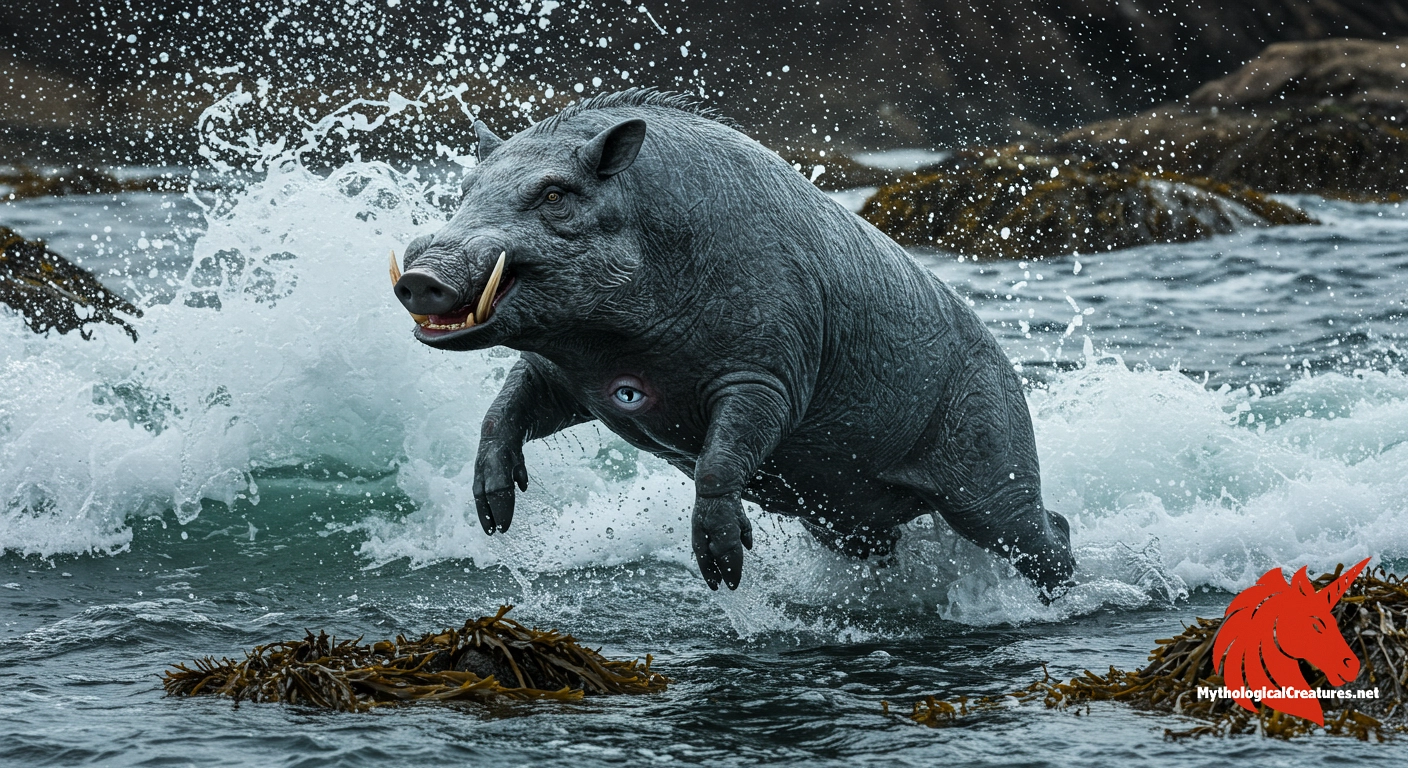Sea Swine: The Sea Swine, also known as Porcus Marinus, is a mythological sea creature with a hog-like head, prominent tusks, and a distinctive single eye at its navel.

Sea Swine
Sea Swine - Represents the conflation of real marine observations with myth, highlighting historical misidentifications in natural history.
Origins & First Encounters
Emerging from the mists of maritime lore, the Sea Swine stands as an enigmatic figure whose origins blend myth with early natural observation. Its earliest mentions can be traced to ancient Greece, where the creature was alternately identified with the familiar porpoise due to its rotund, pig-like shape. Early writers debated whether the term referred to a literal resemblance to a hog or a symbolic reference to the grunts of sea-dwelling animals. Such ambiguity set the stage for a rich tapestry of narratives that evolved over time. These early descriptions laid a foundation that would be elaborated upon by later storytellers and cartographers.
As centuries progressed, the creature found representation in not only literary sources but also in visual art and map illustrations, notably on the Carta marina. Diverse traditions enhanced its legend by infusing imaginative elements with practical observations. The Sea Swine thus came to symbolize both the allure and the peril of the mysterious sea. Its cultural context spans from ancient myth-making to the explorations of the Renaissance, echoing the enduring human fascination with the unknown. The legacy of this mythic animal continues to spark curiosity and scholarly debate in modern times.
Source Texts & Tale Variants
Ancient texts from classical Greece provide some of the earliest references to the Sea Swine, noted under the name Porcus Marinus. Such early documentation oscillated between literal and figurative descriptions, sometimes aligning the creature with the familiar form of a porpoise and other times hinting at its distinctive auditory traits. Early maritime records and manuscripts preserve an ambiguous account, suggesting that the creature occupied a liminal space between real marine life and pure myth. These initial sources were instrumental in framing the creature’s identity as one both natural and fantastical.
Medieval cartography, most notably through the Carta marina, further embellished its legend by featuring wood carvings that depicted the beast with four dragon’s feet and a solitary eye at its navel. Renaissance folklore added further detail by describing it as being headed like a hog, complete with prominent tusks and jagged teeth. Oral traditions across Europe also contributed variations, with some accounts emphasising its tendency to travel in vast, eerie packs. Meanwhile, emerging naturalists such as John Ray attempted to demystify the creature by positing that the so-called Sea Swine was, in fact, the common porpoise. This collision of myth with emerging scientific rationality generated multiple narrative threads that have enriched the creature’s storied past.
Form & Powers
The physical portrayal of the Sea Swine is as fascinating as it is bewildering, merging realistic animal traits with fantastical detail. In several accounts, the creature is envisioned with a robust and rotund body that mirrors the familiar form of a porpoise, yet simultaneously evokes the rounded plumpness of a pig. Its head is described as hog-like, complete with a pronounced snout, formidable tusks, and a set of sharp, jutting teeth that project a sense of raw power. Such features are combined to create an image that challenges simple classification as either natural or supernatural.
Adding to its otherworldly anatomy, some depictions show the beast possessing four dragon-like feet—a detail that seems to defy its otherwise aquatic connotation. A singular, mysterious eye positioned at its navel further deepens the enigma surrounding its form. Variations in the creature’s description suggest that in some traditions, it may have been a large, imposing animal, while in others it appeared as a smaller, more common marine mammal seen in enormous groups. This melding of realistic and fantastical elements results in a creature that is both captivating and elusive in appearance.
Regional Faces
Regional narratives have imbued the Sea Swine with characteristics that uniquely reflect local maritime environments and cultural traditions. In the colder climes of northern Europe, especially in tales surrounding the waters south of Iceland, the creature is often portrayed as a formidable beast endowed with dragon-like limbs and an unusual, solitary eye. These accounts are steeped in the mystique of harsh, uncharted seas, where danger and wonder coalesce in the icy waters. Such depictions have a distinct flavour rooted in the stark, rugged landscapes of the north.
Conversely, Mediterranean and classical traditions tend to offer more naturalistic representations, aligning the creature with the observable traits of a porpoise while still accommodating fantastical embellishments. Local artistic renditions and folklore often meld empirical observation with imaginative narrative, leading to a hybrid creature whose scale and attributes vary widely. In some regions, the Sea Swine is told to roam in massive, chaotic packs, whereas in others it is depicted as a solitary, enigmatic figure. These contrasting portrayals echo the diverse environmental and cultural contexts from which the legends emerged, highlighting the creature’s adaptability as a symbol of maritime mystery.
Cultural Parallels
Comparative mythology reveals that the Sea Swine shares notable similarities with other enigmatic marine creatures found in various cultural traditions. Its depiction—a unique blend of naturalistic features and fantastical attributes—mirrors the dual nature seen in legendary sea monsters across Europe and beyond. For instance, the motif of a singular, central eye echoes the imagery of other one-eyed creatures in myths, serving as a symbol of both insight and otherworldly power. This blending of ordinary animal features with extraordinary embellishments lends it an air of mystery similar to that of other cryptic marine beings.
Across different cultural narratives, parallels emerge with hybrid creatures that combine elements of terrestrial mammals and aquatic life. In some Native American and East Asian traditions, there exist tales of marine beings with unusual anatomical characteristics, reinforcing a universal fascination with anomalies in nature. These shared mythic elements reveal how deeply entrenched the symbolism of the unknown is across seafaring cultures. The Sea Swine ultimately serves as a potent emblem of the strange and unexpected qualities that emerge when nature and myth conflate.
Legacy & Modern Evolution
Tracing the lineage of the Sea Swine unveils a dynamic evolution from its primordial mythic roots to its more refined modern interpretations. Initially anchored in ancient Greek writings and natural observations that likened it to a porpoise, the creature’s image was significantly reworked by medieval and Renaissance artists and cartographers. These visual and literary sources introduced fantastical elements—such as four dragon’s feet and a solitary navel eye—that dramatically expanded its mythic register. As exploratory voyages increased and maritime maps became more detailed, the Sea Swine morphed into a symbol of the unknown terrors and wonders of the sea.
In subsequent centuries, as early naturalists like John Ray sought to rationalise mythical accounts, the creature came to be seen as a misinterpretation of real marine life. Despite this scientific reinterpretation, the legend retained its allure, resonating in both popular culture and scholarly discourse. Modern portrayals, ranging from cryptozoological studies to artistic reimaginings, continue to draw on its rich symbolic heritage. The enduring legacy of the Sea Swine reflects an ongoing human impulse to explain, embellish, and be mystified by the myriad creatures that dwell in the uncharted depths of our world.
Interesting Fact
The Sea Swine remains one of history's most debated cryptids, showcasing how misinterpretations of nature can give rise to enduring myths.
Quick Creature Info
Origin:
Features:
Associations:
Our Mythic Legendary Rating:

Also Sometimes Known As:
Habitat:
Supernatural Powers:
Physical Attributes:
Abilities:
Behavior:
Lore:
Related Creatures, Tales or Lore
- PPorpoise (as referenced by John Ray)
- WWild Boar (noted for hog-like features)
- DDragon (evoked by its four dragon’s feet)
References
Discover Another Mythical Legend You May Not Have Heard Of?
Uncover the mysteries of ancient folklore and expand your knowledge of legendary beings from cultures around the world.
Dare to Meet the Bergelmir....
Mythical Disclaimer: The images and data on this site are derived from various historical and literary sources, but we have found that many myths often have multiple versions and interpretations across references, sometimes contradictory. As a result, these creature depictions are artistic interpretations—imaginative blends of folklore, legend, and a dash of AI guesswork. Because creature descriptions vary widely, our illustrations and accompanying information represent our best effort to honor mythology while bridging creative gaps. Enjoy these interpretations—just remember, we've done our best to respect the stories and validate available data, but in the realm of mythology, details often shift, imagination leads the way, and nothing is ever set in stone!
Curated by the Mythological Creatures Team (rev. May 2025)
